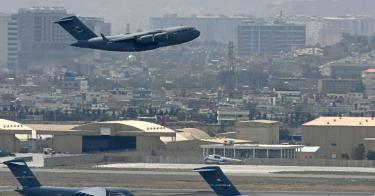L. Frank Baum wrote “The Wonderful Wizard of Oz” almost 40 years before MGM brought the story to the silver screen. Though it’s a classic, the movie is not entirely faithful to the book. The novel tells us the “wizard” is a man who has convinced the citizens of Oz to wear green-tinted glasses to help them buy the notion that they lived in a city made of emeralds.
The wizard’s efforts to shape the perceptions of his people resemble those made by the Biden administration following the precipitous withdrawal of U.S. troops from Afghanistan. But now, even the president’s most ardent supporters are starting to peer over their colored lenses.
Claims that the evacuation was an extraordinary success, that it could not have gone better, or that Americans were not stranded are now widely dismissed. But what about the claim that America’s over-the-horizon (OTH) assets will allow us to identify threats arising in Afghanistan and “act quickly and decisively if needed”?
That assurance, offered to ease fears that Afghanistan will once more become a breeding ground for transnational terrorism, may be the most misleading claim of all.
While our military has incredible capabilities, the constraints of airspace access, transit times and more make quick and decisive action all but impossible.
Landlocked Afghanistan borders six countries: China, Iran, Pakistan, Uzbekistan, Tajikistan, and Turkmenistan. Flight into Afghan airspace from Iran or China is not viable. An approach from Turkmenistan is also unlikely, given that country’s close ties with Russia.
Approaching Afghanistan from the north would require overflying Uzbekistan or Tajikistan—with either of those options also likely requiring overflight of Kazakhstan. Put another way, airspace access from the north will be very hard to secure.
Even with a green light for a northern entry, the closest friendly runways are in Romania and Turkey. Sorties from either would entail 1,500-plus miles and more than three hours of flight time for fighter and airlift platforms (and seven hours for Unmanned Aerial Vehicles like the MQ-9 Reaper)—each way.
How about aircraft launched from ships or airfields in the Persian Gulf? To reach Afghanistan, they must overfly Pakistan, and use of that gateway has been politically episodic. Some days, our aircraft have unfettered access. On others, Pakistan forces pilots to hold at the border for lengthy periods before they are either allowed enter—or told to return home. Now that Pakistan’s cozy relationship with the Taliban is more open, access from the Gulf will become more problematic.
Satellites are not constrained with overflight restrictions. But though they can locate threats, strikes themselves must come from air-breathing assets or cruise missiles that have several other limitations. Rules of engagement will almost always force a target to be observed with an optical sensor before it can be attacked, and regional weather can make that problematic. The civilian casualties that resulted from the Aug. 29 drone strike are a grim reminder of the dangers of launching targeted attacks without having eyes on the ground.
And don’t forget the time that passes between the launch of a long-range weapon and when it hits something. Fighters, bombers and even Tomahawk cruise missiles all fly at roughly the same speeds. The closest Gulf-based assets require more than an hour to reach targets in central Afghanistan and almost two to reach targets in the North. And it takes much longer to get an MQ-9 to either area. Those transit times can impede timely, successful engagements against mobile targets.
With every OTH option being limited by access, transit times, and weather, there is no way American assets can be brought to bear for quick and decisive action to threats arising in Afghanistan. To suggest otherwise is, at best, wishful thinking on the part of the Biden administration.
Yes, somewhere over the horizon, Afghan skies are blue. Unfortunately, without U.S. assets anywhere near Afghanistan, Wonderful Wizard Joe’s counterterrorism dreams really can’t come true.
This piece originally appeared in The Washington Times



